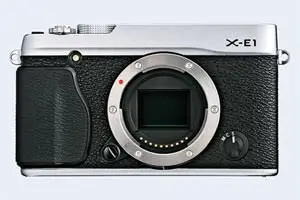Fujifilm X-E1 vs Sony RX10 IV
The Fujifilm X-E1 and the Sony Cyber-shot DSC-RX10 IV are two digital cameras that were announced, respectively, in September 2012 and September 2017. The X-E1 is a mirrorless interchangeable lens camera, while the RX10 IV is a fixed lens compact. The cameras are based on an APS-C (X-E1) and an one-inch (RX10 IV) sensor. The Fujifilm has a resolution of 16 megapixels, whereas the Sony provides 20 MP.
Below is an overview of the main specs of the two cameras as a starting point for the comparison.

Check X-E1 offers at
ebay.com

Check RX10 IV price at
amazon.com
Going beyond this snapshot of core features and characteristics, what are the differences between the Fujifilm X-E1 and the Sony Cyber-shot DSC-RX10 IV? Which one should you buy? Read on to find out how these two cameras compare with respect to their body size, their imaging sensors, their shooting features, their input-output connections, and their reception by expert reviewers.
Body comparison
The side-by-side display below illustrates the physical size and weight of the Fujifilm X-E1 and the Sony RX10 IV. The two cameras are presented according to their relative size. Three consecutive views from the front, the top, and the rear side are shown. All width, height and depth measures are rounded to the nearest millimeter.
The X-E1 can be obtained in two different colors (black, silver), while the RX10 IV is only available in black.
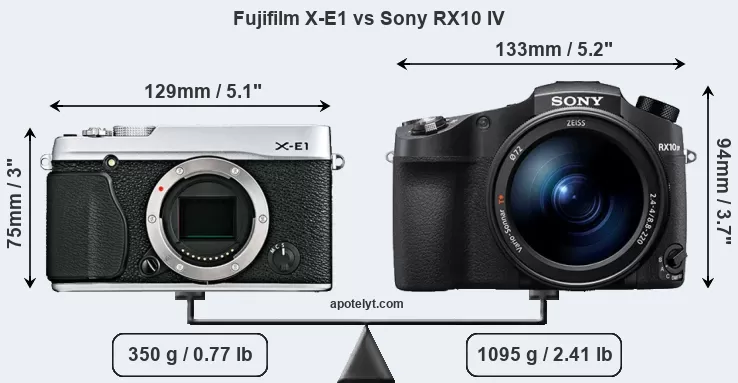
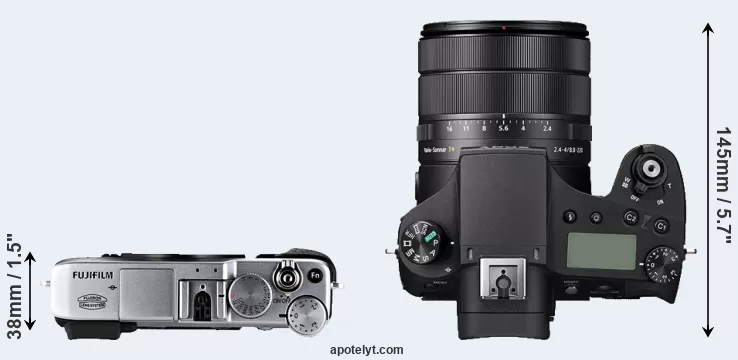
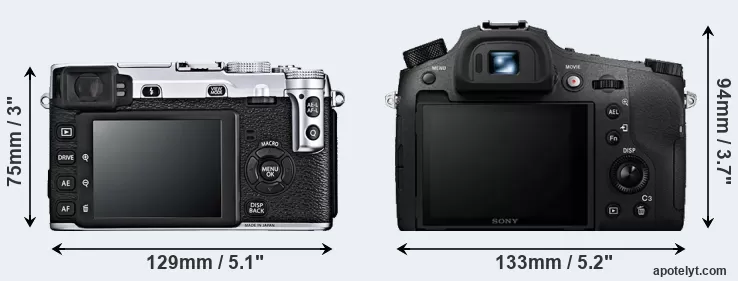
If the front view area (width x height) of the cameras is taken as an aggregate measure of their size, the Sony RX10 IV is notably larger (29 percent) than the Fujifilm X-E1. It is noteworthy in this context that the RX10 IV is splash and dust-proof, while the X-E1 does not feature any corresponding weather-sealing.
The above size and weight comparisons are to some extent incomplete and possibly misleading, as the RX10 IV has a lens built in, whereas the X-E1 is an interchangeable lens camera that requires a separate lens. Attaching the latter will add extra weight and bulk to the setup. You can compare the optics available for the X-E1 and their specifications in the Fujinon X Lens Catalog.
Concerning battery life, the X-E1 gets 350 shots out of its Fujifilm NP-W126 battery, while the RX10 IV can take 400 images on a single charge of its Sony NP-FW50 power pack. The power pack in the RX10 IV can be charged via the USB port, which can be very convenient when travelling.
The following table provides a synthesis of the main physical specifications of the two cameras and other similar ones. In case you want to display and compare another camera duo, you can use the CAM-parator app to select your camera combination among a large number of options.

| Camera Model |
Camera Width |
Camera Height |
Camera Depth |
Camera Weight |
Battery Life |
Weather Sealing |
Camera Launch |
Launch Price |
Street Price |
||
|---|---|---|---|---|---|---|---|---|---|---|---|
| 1. | Fujifilm X-E1 | 129 mm | 75 mm | 38 mm | 350 g | 350 | n | Sep 2012 | US$ 999 | ebay.com | |
| 2. | Sony RX10 IV | 133 mm | 94 mm | 145 mm | 1095 g | 400 | Y | Sep 2017 | US$ 1 699 | amazon.com | |
| 3. | Fujifilm X-A1 | 117 mm | 67 mm | 39 mm | 330 g | 350 | n | Sep 2013 | US$ 399 | ebay.com | |
| 4. | Fujifilm X-A2 | 117 mm | 67 mm | 40 mm | 350 g | 410 | n | Jan 2015 | US$ 399 | ebay.com | |
| 5. | Fujifilm X-A10 | 117 mm | 67 mm | 40 mm | 331 g | 410 | n | Dec 2016 | US$ 399 | ebay.com | |
| 6. | Fujifilm X-E2 | 129 mm | 75 mm | 37 mm | 350 g | 350 | n | Oct 2013 | US$ 999 | ebay.com | |
| 7. | Fujifilm X-E3 | 121 mm | 74 mm | 43 mm | 337 g | 350 | n | Sep 2017 | US$ 899 | ebay.com | |
| 8. | Fujifilm X-M1 | 117 mm | 67 mm | 39 mm | 330 g | 350 | n | Jun 2013 | US$ 699 | ebay.com | |
| 9. | Fujifilm X-Pro1 | 140 mm | 82 mm | 43 mm | 450 g | 300 | n | Jan 2012 | US$ 1 699 | ebay.com | |
| 10. | Fujifilm X-T10 | 118 mm | 83 mm | 41 mm | 381 g | 350 | n | May 2015 | US$ 799 | ebay.com | |
| 11. | Fujifilm X-T20 | 118 mm | 83 mm | 41 mm | 383 g | 350 | n | Jan 2017 | US$ 899 | ebay.com | |
| 12. | Sony NEX-6 | 120 mm | 67 mm | 43 mm | 345 g | 360 | n | Sep 2012 | US$ 999 | ebay.com | |
| 13. | Sony RX10 | 129 mm | 88 mm | 102 mm | 813 g | 420 | Y | Oct 2013 | US$ 1 299 | ebay.com | |
| 14. | Sony RX10 II | 129 mm | 88 mm | 102 mm | 813 g | 400 | Y | Jun 2015 | US$ 1 299 | ebay.com | |
| 15. | Sony RX10 III | 133 mm | 94 mm | 127 mm | 1051 g | 420 | Y | Mar 2016 | US$ 1 499 | ebay.com | |
| 16. | Sony RX100 V | 102 mm | 58 mm | 41 mm | 299 g | 220 | n | Oct 2016 | US$ 999 | ebay.com | |
| 17. | Sony RX100 VI | 102 mm | 58 mm | 43 mm | 301 g | 240 | n | Jun 2018 | US$ 1 199 | ebay.com | |
| Note: Measurements and pricing do not include easily detachable parts, such as add-on or interchangeable lenses or optional viewfinders. | |||||||||||
Any camera decision will obviously take relative prices into account. The listed launch prices provide an indication of the market segment that the manufacturer of the cameras have been targeting. Usually, retail prices stay at first close to the launch price, but after several months, discounts become available. Later in the product cycle and, in particular, when the replacement model is about to appear, further discounting and stock clearance sales often push the camera price considerably down.
Sensor comparison
The imaging sensor is at the core of digital cameras and its size is one of the main determining factors of image quality. All other things equal, a large sensor will have larger individual pixel-units that offer better low-light sensitivity, wider dynamic range, and richer color-depth than smaller pixels in a sensor of the same technological generation. Moreover, a large sensor camera will give the photographer more control over depth-of-field in the image and, thus, the ability to better isolate a subject from the background. On the downside, larger sensors tend to be associated with larger, more expensive camera bodies and lenses.
Of the two cameras under consideration, the Fujifilm X-E1 features an APS-C sensor and the Sony RX10 IV an one-inch sensor. The sensor area in the RX10 IV is 68 percent smaller. As a result of these sensor size differences, the cameras have a format factor of, respectively, 1.5 and 2.7. Both cameras have a native aspect ratio (sensor width to sensor height) of 3:2.
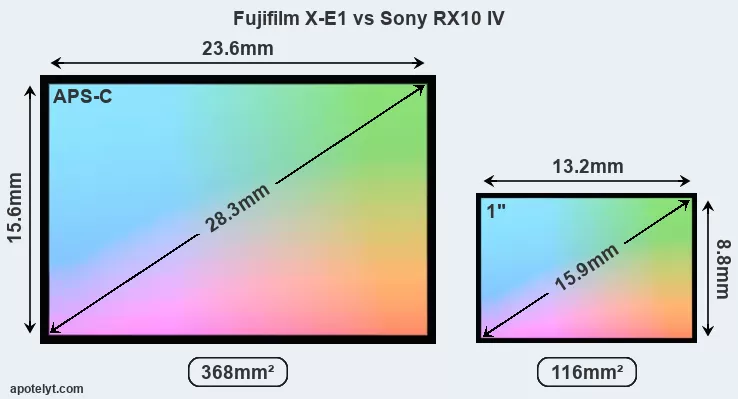
Despite having a smaller sensor, the RX10 IV offers a higher resolution of 20 megapixels, compared with 16 MP of the X-E1. This megapixels advantage comes at the cost of a higher pixel density and a smaller size of the individual pixel (with a pixel pitch of 2.41μm versus 4.80μm for the X-E1). However, it should be noted that the RX10 IV is much more recent (by 5 years) than the X-E1, and its sensor will have benefitted from technological advances during this time that make it possible to gather light more efficiently. Coming back to sensor resolution, it should be mentioned that the X-E1 has no anti-alias filter installed, so that it can capture all the detail its sensor resolves.
The resolution advantage of the Sony RX10 IV implies greater flexibility for cropping images or the possibility to print larger pictures. The maximum print size of the RX10 IV for good quality output (200 dots per inch) amounts to 27.4 x 18.2 inches or 69.5 x 46.3 cm, for very good quality (250 dpi) 21.9 x 14.6 inches or 55.6 x 37.1 cm, and for excellent quality (300 dpi) 18.2 x 12.2 inches or 46.3 x 30.9 cm. The corresponding values for the Fujifilm X-E1 are 24.5 x 16.3 inches or 62.2 x 41.5 cm for good quality, 19.6 x 13.1 inches or 49.7 x 33.2 cm for very good quality, and 16.3 x 10.9 inches or 41.5 x 27.6 cm for excellent quality prints.
The RX10 IV has on-sensor phase detect pixels, which results in fast and reliable autofocus acquisition even during live view operation.
The Fujifilm X-E1 has a native sensitivity range from ISO 200 to ISO 6400, which can be extended to ISO 100-25600. The corresponding ISO settings for the Sony Cyber-shot DSC-RX10 IV are ISO 100 to ISO 12800, with the possibility to increase the ISO range to 64-25600.
In terms of underlying technology, the X-E1 is build around a CMOS sensor, while the RX10 IV uses a BSI-CMOS imager. The X-E1 uses Fujifilm's X-Trans layout of photosites, while the RX10 IV employs the more common Bayer array.
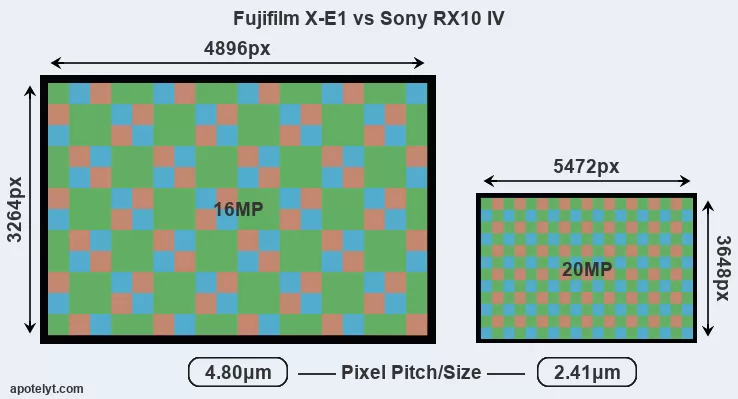
Since 2007, DXO Mark has published sensor performance measurements that have been derived using a consistent methodology. This service assesses and scores the color depth ("DXO Portrait"), dynamic range ("DXO Landscape"), and low-light sensitivity ("DXO Sports") of camera sensors, and also publishes an overall camera score. The following table provides an overview of the physical sensor characteristics, as well as the sensor quality measurements for a selection of comparators.

| Camera Model |
Sensor Class |
Resolution (MP) |
Horiz. Pixels |
Vert. Pixels |
Video Format |
DXO Portrait |
DXO Landscape |
DXO Sports |
DXO Overall |
||
|---|---|---|---|---|---|---|---|---|---|---|---|
| 1. | Fujifilm X-E1 | APS-C | 16.0 | 4896 | 3264 | 1080/24p | 23.2 | 12.4 | 1298 | 75 | |
| 2. | Sony RX10 IV | 1-inch | 20.0 | 5472 | 3648 | 4K/30p | 22.0 | 12.2 | 408 | 63 | |
| 3. | Fujifilm X-A1 | APS-C | 16.0 | 4896 | 3264 | 1080/30p | 23.4 | 12.6 | 1390 | 76 | |
| 4. | Fujifilm X-A2 | APS-C | 16.0 | 4896 | 3264 | 1080/30p | 23.6 | 12.8 | 1515 | 79 | |
| 5. | Fujifilm X-A10 | APS-C | 16.0 | 4896 | 3264 | 1080/30p | 23.9 | 13.2 | 1691 | 81 | |
| 6. | Fujifilm X-E2 | APS-C | 16.0 | 4896 | 3264 | 1080/60p | 23.4 | 12.6 | 1400 | 77 | |
| 7. | Fujifilm X-E3 | APS-C | 24.0 | 6000 | 4000 | 4K/30p | 23.9 | 13.3 | 1764 | 82 | |
| 8. | Fujifilm X-M1 | APS-C | 16.0 | 4896 | 3264 | 1080/30p | 23.4 | 12.6 | 1371 | 76 | |
| 9. | Fujifilm X-Pro1 | APS-C | 16.0 | 4896 | 3264 | 1080/24p | 23.1 | 12.3 | 1238 | 74 | |
| 10. | Fujifilm X-T10 | APS-C | 16.0 | 4896 | 3264 | 1080/60p | 23.7 | 12.9 | 1546 | 79 | |
| 11. | Fujifilm X-T20 | APS-C | 24.0 | 6000 | 4000 | 4K/30p | 23.9 | 13.2 | 1704 | 81 | |
| 12. | Sony NEX-6 | APS-C | 16.0 | 4912 | 3264 | 1080/60i | 23.7 | 13.1 | 1018 | 78 | |
| 13. | Sony RX10 | 1-inch | 20.0 | 5472 | 3648 | 1080/60p | 22.9 | 12.6 | 474 | 69 | |
| 14. | Sony RX10 II | 1-inch | 20.0 | 5472 | 3648 | 4K/30p | 23.0 | 12.6 | 531 | 70 | |
| 15. | Sony RX10 III | 1-inch | 20.0 | 5472 | 3648 | 4K/30p | 23.1 | 12.6 | 472 | 70 | |
| 16. | Sony RX100 V | 1-inch | 20.0 | 5472 | 3648 | 4K/30p | 22.8 | 12.4 | 586 | 70 | |
| 17. | Sony RX100 VI | 1-inch | 20.0 | 5472 | 3648 | 4K/30p | 22.1 | 12.3 | 478 | 64 | |
| Note: DXO values in italics represent estimates based on sensor size and age. | |||||||||||
Many modern cameras are not only capable of taking still images, but can also record movies. Both cameras under consideration have a sensor with sufficiently fast read-out times for moving pictures, but the RX10 IV provides a better video resolution than the X-E1. It can shoot movie footage at 4K/30p, while the Fujifilm is limited to 1080/24p.
Feature comparison
Apart from body and sensor, cameras can and do differ across a range of features. The two cameras under consideration are similar with respect to both having an electronic viewfinder. However, the one in the X-E1 offers a slightly higher resolution than the one in the RX10 IV (2360k vs 2359k dots). The table below summarizes some of the other core capabilities of the Fujifilm X-E1 and Sony RX10 IV in connection with corresponding information for a sample of similar cameras.

| Camera Model |
Viewfinder (Type or 000 dots) |
Control Panel (yes/no) |
LCD Specifications (inch/000 dots) |
LCD Attach- ment |
Touch Screen (yes/no) |
Max Shutter Speed * |
Max Shutter Flaps * |
Built-in Flash (yes/no) |
Built-in Image Stab |
||
|---|---|---|---|---|---|---|---|---|---|---|---|
| 1. | Fujifilm X-E1 | 2360 | n | 2.8 / 460 | fixed | n | 1/4000s | 6.0/s | Y | n | |
| 2. | Sony RX10 IV | 2359 | Y | 3.0 / 1440 | tilting | Y | 1/2000s | 24.0/s | Y | Y | |
| 3. | Fujifilm X-A1 | none | n | 3.0 / 920 | tilting | n | 1/4000s | 5.6/s | Y | n | |
| 4. | Fujifilm X-A2 | none | n | 3.0 / 920 | tilting | n | 1/4000s | 5.6/s | Y | n | |
| 5. | Fujifilm X-A10 | none | n | 3.0 / 1040 | tilting | n | 1/4000s | 6.0/s | Y | n | |
| 6. | Fujifilm X-E2 | 2360 | n | 3.0 / 1040 | fixed | n | 1/4000s | 7.0/s | Y | n | |
| 7. | Fujifilm X-E3 | 2360 | n | 3.0 / 1040 | fixed | Y | 1/4000s | 8.0/s | n | n | |
| 8. | Fujifilm X-M1 | none | n | 3.0 / 920 | tilting | n | 1/4000s | 5.6/s | Y | n | |
| 9. | Fujifilm X-Pro1 | 1440 | n | 3.0 / 1230 | fixed | n | 1/4000s | 6.0/s | n | n | |
| 10. | Fujifilm X-T10 | 2360 | n | 3.0 / 920 | tilting | n | 1/4000s | 8.0/s | Y | n | |
| 11. | Fujifilm X-T20 | 2360 | n | 3.0 / 1040 | tilting | Y | 1/4000s | 8.0/s | Y | n | |
| 12. | Sony NEX-6 | 2359 | n | 3.0 / 921 | tilting | n | 1/4000s | 10.0/s | Y | n | |
| 13. | Sony RX10 | 1440 | Y | 3.0 / 1229 | tilting | n | 1/3200s | 10.0/s | Y | Y | |
| 14. | Sony RX10 II | 2359 | Y | 3.0 / 1229 | tilting | n | 1/3200s | 14.0/s | Y | Y | |
| 15. | Sony RX10 III | 2359 | Y | 3.0 / 1229 | tilting | n | 1/2000s | 14.0/s | Y | Y | |
| 16. | Sony RX100 V | 2359 | n | 3.0 / 1229 | tilting | n | 1/2000s | 24.0/s | Y | Y | |
| 17. | Sony RX100 VI | 2359 | n | 3.0 / 1229 | tilting | Y | 1/2000s | 24.0/s | Y | Y | |
| Note: *) Information refers to the mechanical shutter, unless the camera only has an electronic one. | |||||||||||
One differentiating feature between the two cameras concerns the touch sensitivity of the rear screen. The RX10 IV has a touchscreen, while the X-E1 has a conventional panel. Touch control can be particularly helpful, for example, for setting the focus point.
The reported shutter speed information refers to the use of the mechanical shutter. Yet, some cameras only have an electronic shutter, while others have an electronic shutter in addition to a mechanical one. In fact, the RX10 IV is one of those camera that have an additional electronic shutter, which makes completely silent shooting possible. However, this mode is less suitable for photographing moving objects (risk of rolling shutter) or shooting under artificial light sources (risk of flickering).
The X-E1 writes its imaging data to SDXC cards, while the RX10 IV uses SDXC or Memory Stick PRO Duo cards. Both cameras can use UHS-I cards, which provide for Ultra High Speed data transfer of up to 104 MB/s.
Connectivity comparison
For some imaging applications, the extent to which a camera can communicate with its environment can be an important aspect in the camera decision process. The table below provides an overview of the connectivity of the Fujifilm X-E1 and Sony Cyber-shot DSC-RX10 IV and, in particular, the interfaces the cameras (and selected comparators) provide for accessory control and data transfer.

| Camera Model |
Hotshoe Port |
Internal Mic / Speaker |
Microphone Port |
Headphone Port |
HDMI Port |
USB Port |
WiFi Support |
NFC Support |
Bluetooth Support |
||
|---|---|---|---|---|---|---|---|---|---|---|---|
| 1. | Fujifilm X-E1 | Y | stereo / mono | Y | - | mini | 2.0 | - | - | - | |
| 2. | Sony RX10 IV | Y | stereo / mono | Y | Y | micro | 2.0 | Y | Y | - | |
| 3. | Fujifilm X-A1 | Y | stereo / mono | - | - | mini | 2.0 | Y | - | - | |
| 4. | Fujifilm X-A2 | Y | stereo / mono | - | - | mini | 2.0 | Y | - | - | |
| 5. | Fujifilm X-A10 | - | stereo / mono | - | - | micro | 2.0 | Y | - | - | |
| 6. | Fujifilm X-E2 | Y | stereo / mono | Y | - | micro | 2.0 | Y | - | - | |
| 7. | Fujifilm X-E3 | Y | stereo / mono | Y | - | micro | 2.0 | Y | - | Y | |
| 8. | Fujifilm X-M1 | Y | stereo / mono | - | - | mini | 2.0 | Y | - | - | |
| 9. | Fujifilm X-Pro1 | Y | stereo / mono | - | - | mini | 2.0 | - | - | - | |
| 10. | Fujifilm X-T10 | Y | stereo / mono | Y | - | micro | 2.0 | Y | - | - | |
| 11. | Fujifilm X-T20 | Y | stereo / mono | Y | - | micro | 2.0 | Y | - | - | |
| 12. | Sony NEX-6 | Y | stereo / mono | - | - | mini | 2.0 | Y | - | - | |
| 13. | Sony RX10 | Y | stereo / mono | Y | Y | micro | 2.0 | Y | Y | - | |
| 14. | Sony RX10 II | Y | stereo / mono | Y | Y | micro | 2.0 | Y | Y | - | |
| 15. | Sony RX10 III | Y | stereo / mono | Y | Y | micro | 2.0 | Y | Y | - | |
| 16. | Sony RX100 V | - | stereo / mono | - | - | micro | 2.0 | Y | Y | - | |
| 17. | Sony RX100 VI | - | stereo / mono | - | - | micro | 2.0 | Y | Y | Y |
It is notable that the RX10 IV offers wifi support, which can be a very convenient means to transfer image data to an off-camera location. In contrast, the X-E1 does not provide wifi capability.
The RX10 IV is a recent model that features in the current product line-up of Sony. In contrast, the X-E1 has been discontinued (but can be found pre-owned on ebay). As a replacement in the same line of cameras, the X-E1 was succeeded by the Fujifilm X-E2. Further information on the features and operation of the X-E1 and RX10 IV can be found, respectively, in the Fujifilm X-E1 Manual (free pdf) or the online Sony RX10 IV Manual.
Review summary
So what is the bottom line? Which of the two cameras – the Fujifilm X-E1 or the Sony RX10 IV – has the upper hand? Is one clearly better than the other? A synthesis of the relative strong points of each of the models is listed below.

Advantages of the Fujifilm X-E1:
- Maximized detail: Lacks an anti-alias filter to exploit the sensor's full resolution potential.
- Faster shutter: Has higher mechanical shutter speed (1/4000s vs 1/2000s) to freeze action.
- More flexible: Accepts interchangeable lenses, so that lens characteristics can be altered.
- More compact: Is smaller (129x75mm vs 133x94mm) and thus needs less room in the bag.
- More heavily discounted: Has been available for much longer (launched in September 2012).

Reasons to prefer the Sony Cyber-shot DSC-RX10 IV:
- More detail: Has more megapixels (20 vs 16MP), which boosts linear resolution by 12%.
- Better moiré control: Has an anti-alias filter to avoid artificial patterns to appear in images.
- Better video: Provides higher definition movie capture (4K/30p vs 1080/24p).
- Better live-view autofocus: Features on-sensor phase-detection for more confident autofocus.
- Better sound control: Has a headphone port that enables audio monitoring while recording.
- Easier setting verification: Features a control panel on top to check shooting parameters.
- Larger screen: Has a bigger rear LCD (3.0" vs 2.8") for image review and settings control.
- More detailed LCD: Has a higher resolution rear screen (1440k vs 460k dots).
- More flexible LCD: Has a tilting screen for odd-angle shots in landscape orientation.
- Fewer buttons to press: Has a touchscreen to facilitate handling and shooting adjustments.
- Faster burst: Shoots at higher frequency (24 vs 6 flaps/sec) to capture the decisive moment.
- Less disturbing: Has an electronic shutter option for completely silent shooting.
- Ready to shoot: Has an integrated lens, whereas the X-E1 necessitates an extra lens.
- Longer lasting: Gets more shots (400 versus 350) out of a single battery charge.
- Easier travel charging: Can be conveniently charged via its USB port.
- Better sealing: Is splash and dust sealed for shooting in inclement weather conditions.
- Sharper images: Has stabilization technology built-in to reduce the impact of hand-shake.
- Easier file upload: Has wifi built in for automatic backup or image transfer to the web.
- Easier device pairing: Supports NFC for fast wireless image transfer over short distances.
- More modern: Reflects 5 years of technical progress since the X-E1 launch.
If the count of relative strengths (bullet points above) is taken as a measure, the RX10 IV is the clear winner of the contest (20 : 5 points). However, the pertinence of the various camera strengths will differ across photographers, so that you might want to weigh individual camera traits according to their importance for your own imaging needs before making a camera decision. A professional sports photographer will view the differences between cameras in a way that diverges from the perspective of a street photog, and a person interested in family portraits has distinct needs from a landscape shooter. Hence, the decision which camera is best and worth buying is often a very personal one.
How about other alternatives? Do the specifications of the Fujifilm X-E1 and the Sony RX10 IV place the cameras among the top in their class? Find out in the latest Best Mirrorless Interchangeable Lens Camera and Best Superzoom Camera listings whether the two cameras rank among the cream of the crop.
In any case, while the specs-based evaluation of cameras can be instructive in revealing their potential as photographic tools, it remains incomplete and does no justice, for example, to the way the X-E1 or the RX10 IV perform in practice. User reviews, such as those found at amazon, can sometimes inform about these issues, but such feedback is often incomplete, inconsistent, and biased.
Expert reviews
This is why expert reviews are important. The table below provides a synthesis of the camera assessments of some of the best known photo-gear review sites (amateurphotographer [AP], cameralabs [CL], digitalcameraworld [DCW], dpreview [DPR], ephotozine [EPZ], photographyblog [PB]). As can be seen, the professional reviewers agree in many cases on the quality of different cameras, but sometimes their assessments diverge, reinforcing the earlier point that a camera decision is often a very personal choice.

| Camera Model |
AP score |
CL score |
DCW score |
DPR score |
EPZ score |
PB score |
Camera Launch |
Launch Price |
Street Price |
||
|---|---|---|---|---|---|---|---|---|---|---|---|
| 1. | Fujifilm X-E1 | 4/5 | + + | .. | 79/100 | 4.5/5 | 4.5/5 | Sep 2012 | US$ 999 | ebay.com | |
| 2. | Sony RX10 IV | 5/5 | + | 3.5/5 | 84/100 | 4.5/5 | 5/5 | Sep 2017 | US$ 1 699 | amazon.com | |
| 3. | Fujifilm X-A1 | .. | .. | .. | .. | 4.5/5 | 4.5/5 | Sep 2013 | US$ 399 | ebay.com | |
| 4. | Fujifilm X-A2 | 4/5 | .. | .. | .. | 4.5/5 | 4.5/5 | Jan 2015 | US$ 399 | ebay.com | |
| 5. | Fujifilm X-A10 | .. | .. | .. | .. | 4/5 | 4/5 | Dec 2016 | US$ 399 | ebay.com | |
| 6. | Fujifilm X-E2 | 4/5 | .. | .. | 80/100 | 4.5/5 | 5/5 | Oct 2013 | US$ 999 | ebay.com | |
| 7. | Fujifilm X-E3 | 4.5/5 | + | 4.5/5 | 84/100 | 4.5/5 | 4.5/5 | Sep 2017 | US$ 899 | ebay.com | |
| 8. | Fujifilm X-M1 | 3/5 | + | .. | 77/100 | 4.5/5 | 4.5/5 | Jun 2013 | US$ 699 | ebay.com | |
| 9. | Fujifilm X-Pro1 | 5/5 | + + | .. | 79/100 | 4.5/5 | 4.5/5 | Jan 2012 | US$ 1 699 | ebay.com | |
| 10. | Fujifilm X-T10 | 4.5/5 | + + | .. | 80/100 | 5/5 | 5/5 | May 2015 | US$ 799 | ebay.com | |
| 11. | Fujifilm X-T20 | 5/5 | + + | 5/5 | 82/100 | 5/5 | 4.5/5 | Jan 2017 | US$ 899 | ebay.com | |
| 12. | Sony NEX-6 | 5/5 | + + | .. | 78/100 | 4.5/5 | 4.5/5 | Sep 2012 | US$ 999 | ebay.com | |
| 13. | Sony RX10 | 5/5 | + | .. | 80/100 | 4.5/5 | 4.5/5 | Oct 2013 | US$ 1 299 | ebay.com | |
| 14. | Sony RX10 II | 5/5 | + + | .. | 82/100 | 4.5/5 | 4/5 | Jun 2015 | US$ 1 299 | ebay.com | |
| 15. | Sony RX10 III | 5/5 | + | .. | 84/100 | 4.5/5 | 4.5/5 | Mar 2016 | US$ 1 499 | ebay.com | |
| 16. | Sony RX100 V | 4.5/5 | + + | .. | 83/100 | 4/5 | 4.5/5 | Oct 2016 | US$ 999 | ebay.com | |
| 17. | Sony RX100 VI | 4.5/5 | + + | .. | 83/100 | 4/5 | 4.5/5 | Jun 2018 | US$ 1 199 | ebay.com | |
| Note: (+ +) highly recommended; (+) recommended; (o) reviewed; (..) not available. | |||||||||||
Care should be taken when interpreting the review scores above, though. The ratings were established in reference to similarly priced cameras that were available in the market at the time of the review. A score, therefore, has to be seen in close connection to the price and market introduction time of the camera, and comparing ratings of very distinct cameras or ones that are far apart in terms of their release date have little meaning. Also, please note that some of the review sites have changed their methodology and reporting over time.

Check X-E1 offers at
ebay.com

Check RX10 IV price at
amazon.com
Other camera comparisons
Did this review help to inform your camera decision process? If you would like to see a different side-by-side camera review, just make a corresponding selection in the search boxes below. As an alternative, you can also directly jump to any one of the listed comparisons that were previously generated by the CAM-parator tool.
- Canon 20D vs Fujifilm X-E1
- Canon 77D vs Sony RX10 IV
- Canon T3 vs Sony RX10 IV
- Fujifilm X-E1 vs Leica V-LUX 3
- Fujifilm X-E1 vs Nikon W300
- Fujifilm X-E1 vs Panasonic LX100 II
- Fujifilm X-E1 vs Sony A7S
- Fujifilm X-E1 vs Sony RX10
- Leica M Typ 240 vs Sony RX10 IV
- Nikon D610 vs Sony RX10 IV
- Panasonic G9 II vs Sony RX10 IV
- Samsung NX500 vs Sony RX10 IV
Specifications: Fujifilm X-E1 vs Sony RX10 IV
Below is a side-by-side comparison of the specs of the two cameras to facilitate a quick review of their differences and common features.
| Camera Model | Fujifilm X-E1 | Sony RX10 IV |
|---|---|---|
| Camera Type | Mirrorless system camera | Fixed lens compact camera |
| Camera Lens | Fujifilm X mount lenses | 24-600mm f/2.4-4.0 |
| Launch Date | September 2012 | September 2017 |
| Launch Price | USD 999 | USD 1,699 |
| Sensor Specs | Fujifilm X-E1 | Sony RX10 IV |
| Sensor Technology | CMOS | BSI-CMOS |
| Sensor Format | APS-C Sensor | 1" Sensor |
| Sensor Size | 23.6 x 15.6 mm | 13.2 x 8.8 mm |
| Sensor Area | 368.16 mm2 | 116.16 mm2 |
| Sensor Diagonal | 28.3 mm | 15.9 mm |
| Crop Factor | 1.5x | 2.7x |
| Sensor Resolution | 16 Megapixels | 20 Megapixels |
| Image Resolution | 4896 x 3264 pixels | 5472 x 3648 pixels |
| Pixel Pitch | 4.80 μm | 2.41 μm |
| Pixel Density | 4.34 MP/cm2 | 17.18 MP/cm2 |
| Moiré control | no AA filter | Anti-Alias filter |
| Movie Capability | 1080/24p Video | 4K/30p Video |
| ISO Setting | 200 - 6,400 ISO | 100 - 12,800 ISO |
| ISO Boost | 100 - 25,600 ISO | 64 - 25,600 ISO |
| Image Processor | EXR Processor | BIONZ X |
| Screen Specs | Fujifilm X-E1 | Sony RX10 IV |
| Viewfinder Type | Electronic viewfinder | Electronic viewfinder |
| Viewfinder Field of View | 100% | 100% |
| Viewfinder Magnification | 0.70x | |
| Viewfinder Resolution | 2360k dots | 2359k dots |
| Top-Level Screen | no Top Display | Control Panel |
| LCD Framing | Live View | Live View |
| Rear LCD Size | 2.8inch | 3.0inch |
| LCD Resolution | 460k dots | 1440k dots |
| LCD Attachment | Fixed screen | Tilting screen |
| Touch Input | no Touchscreen | Touchscreen |
| Shooting Specs | Fujifilm X-E1 | Sony RX10 IV |
| Focus System | Contrast-detect AF | On-Sensor Phase-detect |
| Manual Focusing Aid | Focus Peaking | Focus Peaking |
| Max Shutter Speed (mechanical) | 1/4000s | 1/2000s |
| Continuous Shooting | 6 shutter flaps/s | 24 shutter flaps/s |
| Electronic Shutter | no E-Shutter | up to 1/32000s |
| Fill Flash | Built-in Flash | Built-in Flash |
| Storage Medium | SDXC cards | MS or SDXC cards |
| Single or Dual Card Slots | Single card slot | Single card slot |
| UHS card support | UHS-I | UHS-I |
| Connectivity Specs | Fujifilm X-E1 | Sony RX10 IV |
| External Flash | Hotshoe | Hotshoe |
| USB Connector | USB 2.0 | USB 2.0 |
| HDMI Port | mini HDMI | micro HDMI |
| Microphone Port | External MIC port | External MIC port |
| Headphone Socket | no Headphone port | Headphone port |
| Wifi Support | no Wifi | Wifi built-in |
| Near-Field Communication | no NFC | NFC built-in |
| Body Specs | Fujifilm X-E1 | Sony RX10 IV |
| Environmental Sealing | not weather sealed | Weathersealed body |
| Battery Type | Fujifilm NP-W126 | Sony NP-FW50 |
| Battery Life (CIPA) | 350 shots per charge | 400 shots per charge |
| In-Camera Charging | no USB charging | USB charging |
| Body Dimensions |
129 x 75 x 38 mm (5.1 x 3.0 x 1.5 in) |
133 x 94 x 145 mm (5.2 x 3.7 x 5.7 in) |
| Camera Weight | 350 g (12.3 oz) | 1095 g (38.6 oz) |

Check X-E1 offers at
ebay.com

Check RX10 IV price at
amazon.com
Did you notice an error on this page? If so, please get in touch, so that we can correct the information.
